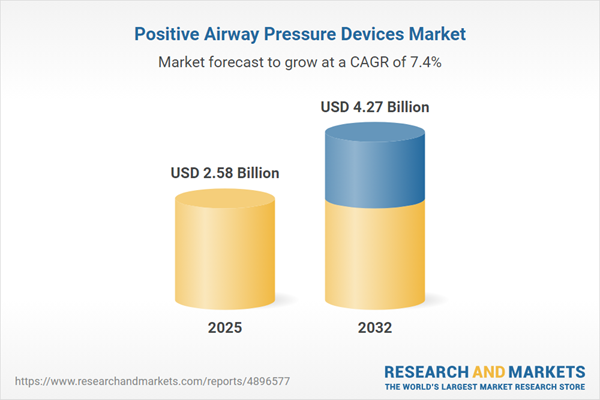Speak directly to the analyst to clarify any post sales queries you may have.
The Positive Airway Pressure Devices Market is evolving as a critical segment within advanced respiratory care, driven by the convergence of technological enhancements and a focus on meeting diverse patient needs. This analysis equips leaders with actionable intelligence to navigate an increasingly complex landscape marked by global supply challenges, regulatory shifts, and demand for patient-centric care solutions.
Market Snapshot: Positive Airway Pressure Devices Market Size and Growth
The global market for positive airway pressure devices grew from USD 2.41 billion in 2024 to USD 2.58 billion in 2025, reflecting continued expansion. Forecasts indicate an ongoing CAGR of 7.36%, with market value projected to reach USD 4.27 billion by 2032. This expansion is underpinned by rising prevalence of sleep-related breathing disorders, improved healthcare infrastructure, and broadening access to respiratory therapies across established and emerging regions.
Scope & Segmentation
This report delivers a comprehensive review of developments shaping the positive airway pressure devices market. Segmentation spans product types, technologies, patient categories, end-users, distribution channels, and geographies, providing a granular view to inform business strategy.
- Product Types: Auto adjusting positive airway pressure, bi-level positive airway pressure, continuous positive airway pressure
- Device Types: Accessories, face masks, humidifiers
- Applications: Central sleep apnea, chronic impediments, obstructive sleep apnea
- Patient Types: Adult, geriatric, pediatric
- End Users: Homecare settings, hospitals, laboratories & clinics
- Distribution Channels: Hospital pharmacies, specialty stores, online retail
- Regions: Americas (United States, Canada, Mexico, Brazil, Argentina, Chile, Colombia, Peru), Europe (United Kingdom, Germany, France, Russia, Italy, Spain, Netherlands, Sweden, Poland, Switzerland), Middle East (United Arab Emirates, Saudi Arabia, Qatar, Turkey, Israel), Africa (South Africa, Nigeria, Egypt, Kenya), Asia-Pacific (China, India, Japan, Australia, South Korea, Indonesia, Thailand, Malaysia, Singapore, Taiwan)
- Companies: 3B Medical Inc., Apex Medical Corporation, Armstrong Medical Ltd, Becton Dickinson and Company, BMC Medical Co. Ltd., Breas Medical AB, Cadwell Industries Inc., DeVilbiss Healthcare LLC, Drive Devilbliss Healthcare Ltd., Fisher & Paykel Healthcare Limited, Invacare Corporation, Koninklijke Philips N.V., Lowenstein Medical UK Ltd, medin Medical Innovations GmbH, Microchip Technology Inc., Narang Medical Limited, Nationwide Medical Supply Inc., ResMed Inc., Salter Labs Inc., Smith's Group PLC, Teijin Pharma Limited, Texas Instruments Incorporated, Vyaire Medical Inc., Weinmann Medical Technology GmbH + Co. KG
Key Takeaways for Industry Leaders
- Advanced sensing algorithms and intelligent feedback in auto-adjusting and bi-level systems are setting new standards in personalized respiratory therapy.
- Growing focus on ergonomic mask materials and adaptive interfaces enhances patient comfort and long-term treatment adherence, especially across pediatric and geriatric populations.
- Integration of wireless connectivity and telemedicine infrastructure enables real-time monitoring, allowing clinicians to adjust protocols remotely and boost therapy compliance.
- Material innovations and sustainability concerns are driving the adoption of biodegradable components and energy-efficient electronics within leading products.
- Collaboration between manufacturers and software developers is elevating device value through digital coaching, compliance incentives, and patient education modules.
Tariff Impact: Supply Chain and Cost Structures
Recent United States tariffs have created renewed urgency for supply chain diversification. Manufacturers are exploring regional sourcing and nearshoring strategies to mitigate the impact of increased component costs, especially for microprocessors and silicone materials. Contract renegotiations and pilot projects using domestically sourced parts are fostering stronger resilience. Industry players are also formulating advocacy alliances to seek tariff exemptions for medically essential equipment.
Methodology & Data Sources
This analysis builds upon rigorous secondary research, including peer-reviewed journals, regulatory filings, and corporate disclosures. Findings were triangulated with primary interviews from clinicians, procurement leaders, and respiratory therapists across key markets. Data validation ensures a balanced and realistic portrayal of strategic dynamics and trends.
The Positive Airway Pressure Devices Market: Why This Report Matters
- Receive a detailed breakdown of high-growth segments, technology integration, and evolving patient care models to refine investment and R&D strategies.
- Understand region-specific opportunities, regulatory pathways, and distribution channel dynamics to support market entry or expansion planning.
- Gain insights into the actions of leading companies and emerging disruptors within the positive airway pressure devices sector for benchmarking and partnership identification.
Conclusion
Senior decision-makers can draw on this analysis to anticipate market shifts, drive innovation, and adapt business models in line with evolving global respiratory care needs. A strategic approach to sourcing, technology, and regional diversity remains critical for sustained market leadership.
Additional Product Information:
- Purchase of this report includes 1 year online access with quarterly updates.
- This report can be updated on request. Please contact our Customer Experience team using the Ask a Question widget on our website.
Table of Contents
3. Executive Summary
4. Market Overview
7. Cumulative Impact of Artificial Intelligence 2025
Companies Mentioned
The companies profiled in this Positive Airway Pressure Devices market report include:- 3B Medical, Inc.
- Apex Medical Corporation
- Armstrong Medical Ltd
- Becton, Dickinson and Company
- BMC Medical Co., Ltd.
- Breas Medical AB
- Cadwell Industries, Inc.
- DeVilbiss Healthcare LLC
- Drive Devilbliss Healthcare Ltd.
- Fisher & Paykel Healthcare Limited
- Invacare Corporation
- Koninklijke Philips N.V.
- Lowenstein Medical UK Ltd
- medin Medical Innovations GmbH
- Microchip Technology Inc.
- Narang Medical Limited
- Nationwide Medical Supply, Inc.
- ResMed Inc.
- Salter Labs Inc.
- Smith’s Group PLC
- Teijin Pharma Limited
- Texas Instruments Incorporated
- Vyaire Medical, Inc.
- Weinmann Medical Technology GmbH + Co. KG
Table Information
| Report Attribute | Details |
|---|---|
| No. of Pages | 183 |
| Published | November 2025 |
| Forecast Period | 2025 - 2032 |
| Estimated Market Value ( USD | $ 2.58 Billion |
| Forecasted Market Value ( USD | $ 4.27 Billion |
| Compound Annual Growth Rate | 7.3% |
| Regions Covered | Global |
| No. of Companies Mentioned | 25 |









